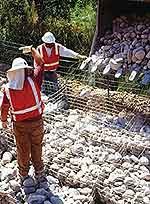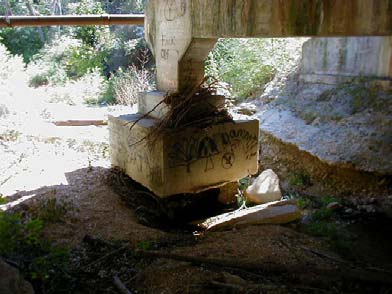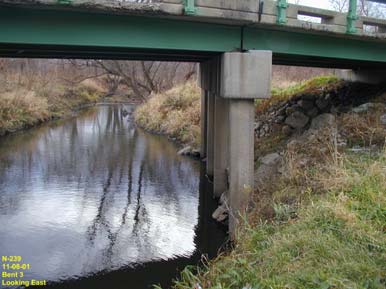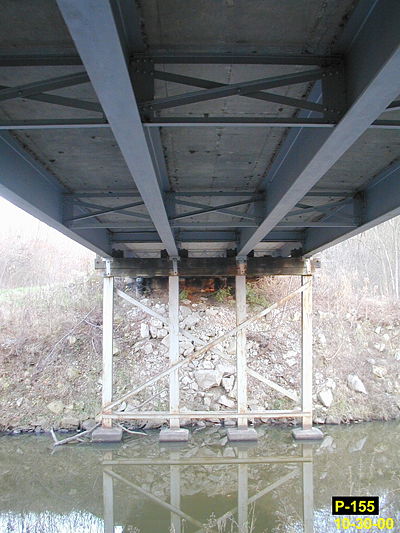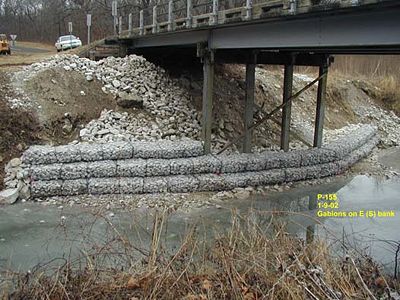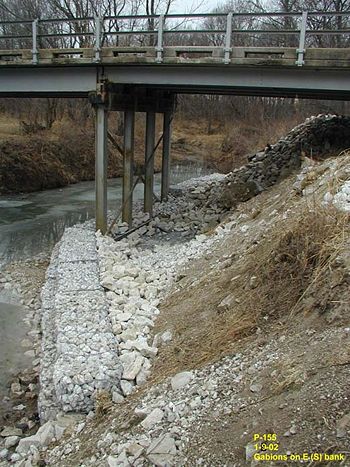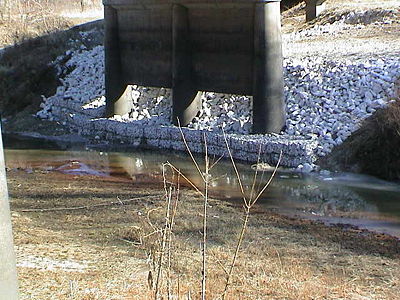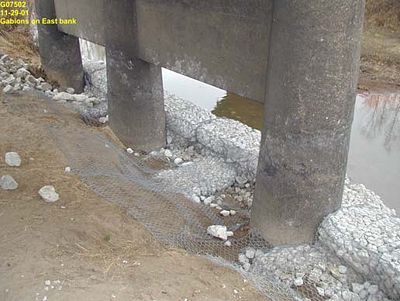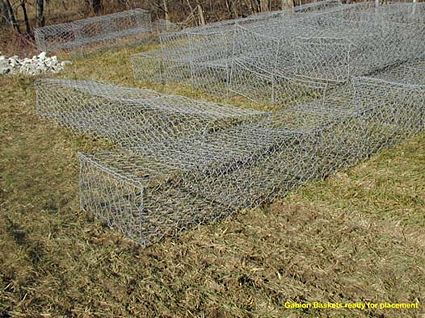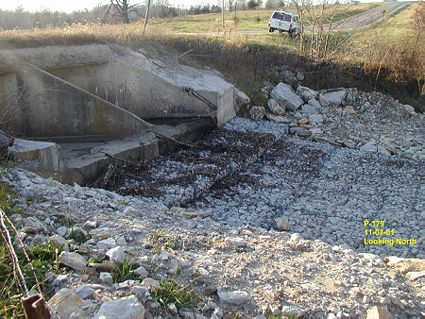Difference between revisions of "611.4 Gabions"
m (updated links) |
|||
| Line 1: | Line 1: | ||
==611.4.1 Design== | ==611.4.1 Design== | ||
[[image:611.4 Photo Gabion.jpg|right|150 px]] | [[image:611.4 Photo Gabion.jpg|right|150 px]] | ||
| − | Gabions are useful to control erosion around bridge and culvert structures or other locations subject to scouring at the base of the embankment or drainage channel. Gabions and mattresses consist of rectangular units, fabricated from welded wire fabric or twisted hexagonal mesh zinc or PVC (polyvinyl chloride) coated wire. Filled with stone, gabions become large, flexible and permeable elements from which a broad range of structures can be built (retaining walls, river bank protection, weirs, etc.). Gabions are divided into cells with diaphragms, whose function is to reinforce the structure. Vegetation that establishes in the gabion will provide further reinforcement. The MoDOT gabion specification in [http://www.modot. | + | Gabions are useful to control erosion around bridge and culvert structures or other locations subject to scouring at the base of the embankment or drainage channel. Gabions and mattresses consist of rectangular units, fabricated from welded wire fabric or twisted hexagonal mesh zinc or PVC (polyvinyl chloride) coated wire. Filled with stone, gabions become large, flexible and permeable elements from which a broad range of structures can be built (retaining walls, river bank protection, weirs, etc.). Gabions are divided into cells with diaphragms, whose function is to reinforce the structure. Vegetation that establishes in the gabion will provide further reinforcement. The MoDOT gabion specification in [http://www.modot.org/business/standards_and_specs/SpecbookEPG.pdf#page=9 Section 611] is intended for erosion control applications with one or two tiers of gabion baskets, at approximate heights of four feet or less. Applications with higher stacking of baskets that will function as retaining walls need additional design considerations as to the size and configuration of the gabion. |
ASTM Standards A 974-97 and A 975-97 as referenced in Section 611 allow a variety of wire types. The contractor has the option to select the basket type and manufacturer. The designer should determine if the gabion is subject to standing water. For a wet/dry environment, the plans should note where PVC coated wire is required. The designer may also require a qualified manufacturer’s representative to be on-site at the beginning of each gabion installation to review standard installation procedures with the contractor and the owner’s representative. If a neat appearance is desired, the plans should require hand stacking of the front face. | ASTM Standards A 974-97 and A 975-97 as referenced in Section 611 allow a variety of wire types. The contractor has the option to select the basket type and manufacturer. The designer should determine if the gabion is subject to standing water. For a wet/dry environment, the plans should note where PVC coated wire is required. The designer may also require a qualified manufacturer’s representative to be on-site at the beginning of each gabion installation to review standard installation procedures with the contractor and the owner’s representative. If a neat appearance is desired, the plans should require hand stacking of the front face. | ||
| Line 16: | Line 16: | ||
===Material=== | ===Material=== | ||
| − | Refer to [http://www.modot. | + | Refer to [http://www.modot.org/business/standards_and_specs/SpecbookEPG.pdf#page=9 Standard Specification Section 611.70] and this guidance for materials and methods of installations for gabions. Review the manufacturer’s installation guide for proper materials. |
===Safety=== | ===Safety=== | ||
Latest revision as of 08:59, 9 June 2016
Contents
611.4.1 Design
Gabions are useful to control erosion around bridge and culvert structures or other locations subject to scouring at the base of the embankment or drainage channel. Gabions and mattresses consist of rectangular units, fabricated from welded wire fabric or twisted hexagonal mesh zinc or PVC (polyvinyl chloride) coated wire. Filled with stone, gabions become large, flexible and permeable elements from which a broad range of structures can be built (retaining walls, river bank protection, weirs, etc.). Gabions are divided into cells with diaphragms, whose function is to reinforce the structure. Vegetation that establishes in the gabion will provide further reinforcement. The MoDOT gabion specification in Section 611 is intended for erosion control applications with one or two tiers of gabion baskets, at approximate heights of four feet or less. Applications with higher stacking of baskets that will function as retaining walls need additional design considerations as to the size and configuration of the gabion.
ASTM Standards A 974-97 and A 975-97 as referenced in Section 611 allow a variety of wire types. The contractor has the option to select the basket type and manufacturer. The designer should determine if the gabion is subject to standing water. For a wet/dry environment, the plans should note where PVC coated wire is required. The designer may also require a qualified manufacturer’s representative to be on-site at the beginning of each gabion installation to review standard installation procedures with the contractor and the owner’s representative. If a neat appearance is desired, the plans should require hand stacking of the front face.
611.4.2 Construction Inspection (Sec 611.70.3)
It is critical that the contractor follow the manufacturer’s recommendations for installation along with maximum and minimum rock size. When installed correctly the baskets will be true to the lines and grades shown on the plans. Gabions that sag, bulge or have damaged wires should not be accepted. Backfill should be with finely crushed stone or gravel.
611.4.3 Materials Inspection
The Materials Division does not normally perform field inspection on this item.
611.4.4 Bridge Maintenance
Use of gabions may prevent or arrest bank and streambed erosion that could affect the stability of the structure. Stream scour begins at the bottom of the slope at streambed level. That area must be protected or the scour will continue. Gabions must be placed to protect that area or support the material there.
Material
Refer to Standard Specification Section 611.70 and this guidance for materials and methods of installations for gabions. Review the manufacturer’s installation guide for proper materials.
Safety
All utilities must be located.
Scheduling
Gabion installation along stream banks at the water line would have to be scheduled for the summer months when the weather and water temperatures are comfortable. A period of low stream flow should be chosen for this work.
Gabion installation in dry streams and in locations that are not in contact with the stream flow could be scheduled at any time that the earth in the area is workable.
Procedures
1. Review the available guidance to determine the size and number of gabion baskets required.
2. Review guidance for working in Wetlands and Streams, review the location with Corp of Engineer personnel, and determine if a section 404 Permit is required. If necessary, obtain permit before the work begins and inform the crew of the Corp regulations before beginning the project.
3. Choose assembly site for gabions.
4. Prepare the site and install the gabions in accordance with guidelines established by the manufacturer and Corp regulations.
5. Backfill the gabions with proper material.
